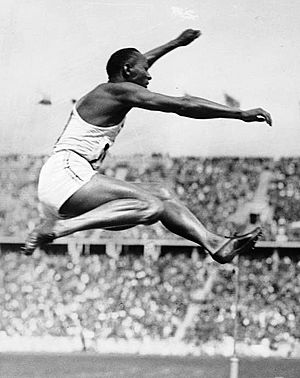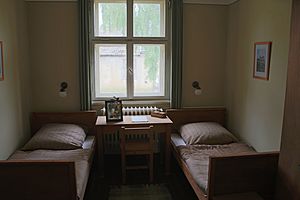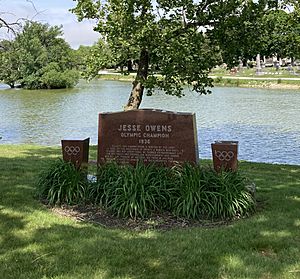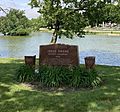Jesse Owens facts for kids
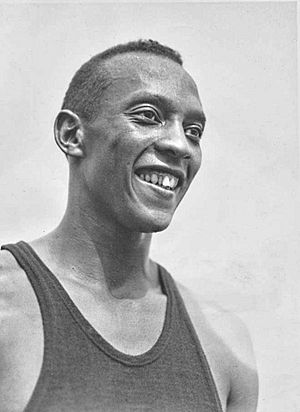
Owens at the 1936 Summer Olympics, where he won four Olympic gold medals
|
|||||||||||||||||||||||
| Personal information | |||||||||||||||||||||||
|---|---|---|---|---|---|---|---|---|---|---|---|---|---|---|---|---|---|---|---|---|---|---|---|
| Full name | James Cleveland Owens | ||||||||||||||||||||||
| Nationality | American | ||||||||||||||||||||||
| Born | September 12, 1913 Oakville, Alabama, U.S. |
||||||||||||||||||||||
| Died | March 31, 1980 (aged 66) Tucson, Arizona, U.S. |
||||||||||||||||||||||
| Resting place | Oak Woods Cemetery Chicago, Illinois, U.S. |
||||||||||||||||||||||
| Education | Ohio State University, Fairmont Junior High School, East Technical High School |
||||||||||||||||||||||
| Height | 5 ft 11 in | ||||||||||||||||||||||
| Weight | 165 lb | ||||||||||||||||||||||
| Spouse(s) |
M. Ruth Solomon
(m. 1935) |
||||||||||||||||||||||
| Sport | |||||||||||||||||||||||
| Sport | Track and field | ||||||||||||||||||||||
| Event(s) | Sprint, Long jump | ||||||||||||||||||||||
| Achievements and titles | |||||||||||||||||||||||
| Personal best(s) | 60 yd: 6.1 100 yd: 9.4 100 m: 10.2 200 m: 20.7 220 yd: 20.3 |
||||||||||||||||||||||
|
Medal record
|
|||||||||||||||||||||||
James Cleveland "Jesse" Owens (born September 12, 1913 – died March 31, 1980) was an amazing American track and field athlete. He became famous for winning four gold medals at the 1936 Summer Olympics in Berlin, Germany.
Jesse Owens achieved international fame at these Olympic Games. He won gold in the 100 meters, long jump, 200 meters, and the 4 × 100-meter relay. He was the most successful athlete at the Games. As a black American man, his victories were seen as a powerful message against Adolf Hitler's ideas of "Aryan supremacy."
Contents
Early Life and School
Jesse Owens was born as J.C. (James Cleveland) Owens in Oakville, Alabama. He was the youngest of ten children. His family were sharecroppers, meaning they farmed land owned by someone else and paid rent with a share of their crops. His grandfather had been a slave.
When Jesse was nine, his family moved to Cleveland, Ohio. They were part of the Great Migration, when many African Americans moved from the southern United States to the northern cities. They hoped for better opportunities and to escape racial segregation. When Jesse started school, his teacher misunderstood his Southern accent. She thought he said "Jesse" instead of "J.C.", and the name stuck!
As a young person, Jesse worked many jobs to help his family. He delivered groceries and worked in a shoe repair shop. He soon discovered his love for running. Jesse always said his junior high school coach, Charles Riley, helped him a lot. Since Jesse worked after school, Coach Riley let him practice before school started.
Jesse first gained national attention in high school. He ran the 100-yard dash in 9.4 seconds, which was a world record at the time. He also had an incredible long jump of 24 feet 9+1⁄2 inches (7.56 m) at a championship in Chicago in 1933.
College Career
Jesse Owens went to Ohio State University. He was known as the "Buckeye Bullet" because of his speed. His coach was Larry Snyder. Jesse won a record eight individual championships in college track and field. He won four in 1935 and four more in 1936.
Because of his race, Jesse faced challenges. He had to live off campus with other black athletes. When the team traveled, he could only eat at "blacks-only" restaurants or get food to go. He also had to stay in hotels that only allowed black people. Jesse did not get a scholarship, so he worked part-time jobs to pay for his education.
A Day of Records
May 25, 1935, was an amazing day for Jesse Owens. In just 45 minutes, he set three new world records and tied another! This happened at a track meet in Ann Arbor, Michigan.
He tied the world record for the 100-yard dash (9.4 seconds). He then set new world records in:
- The long jump (26 feet 8+1⁄4 inches or 8.13 metres). This record lasted for 25 years!
- The 220 yards (201.2 m) sprint (20.3 seconds).
- The 220-yard low hurdles (22.6 seconds). He was the first person to run this race in under 23 seconds.
Many people call this day "the greatest 45 minutes ever in sport."
The 1936 Berlin Summer Olympics
Before the 1936 Berlin Olympics, some groups like the NAACP suggested that African American athletes should not go. They felt it would support a government that was racist. Jesse Owens even thought the United States should not participate. But in the end, he and other athletes decided to compete.
Jesse Owens and his teammates traveled to Germany on a ship called the SS Manhattan. When they arrived at the Olympic stadium, many fans, especially young girls, were shouting, "Where is Jesse? Where is Jesse?"
On August 3, Jesse won his first gold medal in the 100-meter dash. He finished in 10.3 seconds. On August 4, he won the long jump with a leap of 8.06 metres (26 ft 5 in). He later said that the German competitor, Luz Long, gave him helpful advice. On August 5, he won the 200-meter sprint in 20.7 seconds. On August 9, Jesse won his fourth gold medal in the 4 × 100-meter sprint relay. The team set a new world record of 39.8 seconds. Jesse had protested a last-minute change to the team, but his coach told him he had to run.
Jesse Owens's amazing achievement of four gold medals was not matched until Carl Lewis did the same in 1984. Adolf Hitler, the leader of Germany, was upset by Owens's success. He had hoped that German athletes would win most of the medals. Hitler believed that people from Africa were "primitive" and should not be allowed in future games.
Life After the Olympics

When Jesse Owens returned to the United States, he was a hero. He was greeted with a huge parade in New York City. During the parade, someone secretly gave him a bag with $10,000 cash!
However, even after his Olympic wins, Jesse still faced racial segregation in the United States. In Germany, he had been allowed to stay in the same hotels as white athletes. But in New York, after his parade, he was not allowed to enter the main doors of the fancy Waldorf Astoria hotel for a reception in his honor. He had to use a freight elevator. Also, President Franklin D. Roosevelt never invited Jesse Owens to the White House.
After the Olympics, the U.S. athletic officials took away Jesse's "amateur status." This meant he could no longer compete in amateur sports events. This ended his career as a competitive athlete. Jesse was angry because he had faced racial discrimination throughout his life. He had to work hard to pay for college and couldn't get scholarships.
Jesse found it hard to find work, even with his fame. He worked as a gas station attendant and a janitor. He even raced against horses for money to earn a living. He said, "People say that it was degrading for an Olympic champion to run against a horse, but what was I supposed to do? I had four gold medals, but you can't eat four gold medals."
Later, Jesse worked at the Ford Motor Company. He also started his own public relations business. In 1955, President Dwight D. Eisenhower asked Jesse to be a "goodwill ambassador." Jesse traveled to different countries to promote exercise and American values. He continued these tours for many years.
Jesse Owens continued to work with companies and speak to groups like the United States Olympic Committee. In 1972, he and his wife moved to Arizona.
Family Life
Jesse Owens met Minnie Ruth Solomon when he was 15 and she was 13. They dated through high school and got married on July 5, 1935. They had three daughters: Gloria, Marlene, and Beverly. They stayed married until Jesse's death in 1980.
Death
Jesse Owens passed away on March 31, 1980, at the age of 66, from lung cancer. He was buried at Oak Woods Cemetery in Chicago.
President Jimmy Carter honored Jesse Owens after he died. He said, "Perhaps no athlete better symbolized the human struggle against tyranny, poverty and racial bigotry."
Jesse Owens's Inspiring Words
- "I let my feet spend as little time on the ground as possible. From the air, fast down, and from the ground, fast up."
- "One chance is all you need."
- "I always loved running... it was something you could do by yourself, and under your own power. You could go in any direction, fast or slow as you wanted, fighting the wind if you felt like it, seeking out new sights just on the strength of your feet and the courage of your lungs."
- "Find the good. It's all around you. Find it, showcase it and you'll start believing in it."
- "We all have dreams. But in order to make dreams come into reality, it takes an awful lot of determination, dedication, self-discipline, and effort."
- "The road to the Olympics, leads to no city, no country. It goes far beyond New York or Moscow, ancient Greece or Nazi Germany. The road to the Olympics leads — in the end — to the best within us."
- "The battles that count aren’t the ones for gold medals. The struggles within yourself – the invisible, inevitable battles inside all of us – that’s where it’s at."
- "Awards become corroded, friends gather no dust."
Interesting Facts About Jesse Owens
- Jesse Owens was known for his speed in sprint races and his skill in the long jump.
- Many people consider him "perhaps the greatest and most famous athlete in track and field history."
- His incredible day in 1935, where he set three world records and tied another in less than an hour, is still unmatched.
- The Jesse Owens Award is a top honor given to the best track and field athlete in the U.S. each year.
- ESPN ranked him as the sixth greatest North American athlete of the 20th century.
- The dormitory where Owens stayed during the Berlin Olympics has been restored. It is now a museum with pictures of his achievements.
- In 2016, a movie called Race was made about Jesse Owens's life.
- The founder of Adidas shoes, Adi Dassler, convinced Owens to wear his shoes at the 1936 Olympics. This was one of the first sponsorships for a black athlete.
- Owens's long jump world record from 1935 lasted for 25 years! It was broken in 1960 by Ralph Boston, and Owens was there to see it.
- His long jump victory is shown in the 1938 film Olympia.
Awards and Honors
- 1936: Named AP Athlete of the Year.
- 1936: Received four English oak saplings from the German Olympic Committee, one for each gold medal.
- 1970: Inducted into the Alabama Sports Hall of Fame.
- 1976: Awarded the Presidential Medal of Freedom by President Gerald Ford.
- 1976: Received the Silver Olympic Order for his victories and his dedication to sports.
- 1979: Awarded the Library of Congress Living Legend Award by President Jimmy Carter.
- 1980: An asteroid was named 6758 Jesseowens in his honor.
- 1981: The Jesse Owens Award was created by USA Track and Field.
- 1983: Became part of the first group inducted into the U.S. Olympic Hall of Fame.
- 1984: A street near the Olympic Stadium in Berlin was renamed Jesse-Owens-Allee.
- 1990: Posthumously awarded the Congressional Gold Medal by President George H. W. Bush.
- 1990 and 1998: Two U.S. postage stamps were issued to honor him.
- 1996: His hometown of Oakville, Alabama, opened the Jesse Owens Memorial Park and Museum.
- 2001: Ohio State University dedicated Jesse Owens Memorial Stadium for track and field events.
- 2009: At the 2009 World Athletic Championships in Berlin, U.S. team members wore badges with "JO" to remember Owens.
- 2012: Footage of Owens running was shown on a giant video screen during the 2012 Summer Olympics opening ceremony in London.
- A statue of Owens is in Fort Huntington Park in Cleveland, Ohio.
- Phoenix, Arizona has the Jesse Owens Medical Centre and Jesse Owens Parkway.
- Jesse Owens Park in Tucson, Arizona, is a popular place for youth sports.
- In July 2018, the 75th state park in Ohio was named Jesse Owens State Park.
Literature and Film
- 1984: An Emmy Award-winning television film about his life, The Jesse Owens Story, was released.
- 2016: A movie called Race was made about Owens, with Stephan James playing him.
Images for kids
See also
 In Spanish: Jesse Owens para niños
In Spanish: Jesse Owens para niños


